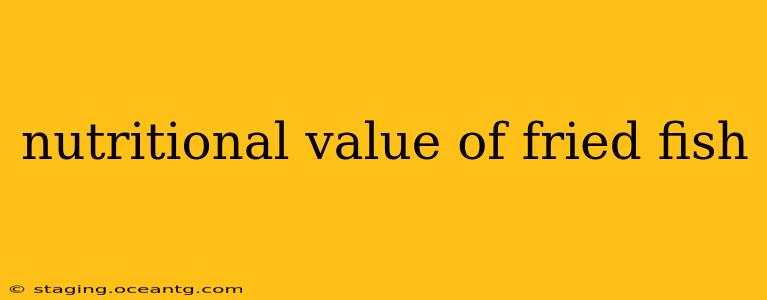Fried fish is a popular dish worldwide, enjoyed for its crispy texture and savory flavor. However, the nutritional value of fried fish is a complex topic, significantly impacted by the frying method and the type of fish used. While it can offer some health benefits, the preparation method often overshadows the inherent nutritional value of the fish itself. Let's explore this in detail.
What are the Nutritional Benefits of Fish in General?
Before delving into the impact of frying, let's establish the baseline nutritional benefits of fish. Fish is a fantastic source of:
- High-Quality Protein: Essential for building and repairing tissues, crucial for growth and overall health.
- Omega-3 Fatty Acids: These healthy fats are linked to reduced risk of heart disease, stroke, and certain types of cancer. Fatty fish like salmon, tuna, and mackerel are particularly rich in Omega-3s.
- Vitamins and Minerals: Fish is a good source of Vitamin D, Vitamin B12, selenium, and iodine, all vital for various bodily functions.
- Low in Saturated Fat (Generally): Many fish varieties are relatively low in saturated fat, making them a heart-healthier protein source compared to red meat.
How Does Frying Affect the Nutritional Value of Fish?
The frying process significantly alters the nutritional profile of fish, often diminishing its health benefits and adding undesirable elements:
- Increased Fat and Calories: Frying adds a significant amount of fat and calories, primarily from the cooking oil. The type of oil used plays a crucial role – unhealthy fats from oils like partially hydrogenated oils greatly increase the negative impact.
- Reduced Omega-3s (Potentially): While not always the case, high temperatures during frying can potentially damage some of the beneficial Omega-3 fatty acids.
- Formation of Harmful Compounds: High-heat cooking can lead to the formation of acrylamide, a compound potentially linked to cancer risk. Additionally, the oil can break down into harmful compounds if reused multiple times.
- Increased Sodium: Many fried fish recipes include breading or batter, often high in sodium.
What are the Health Risks Associated with Eating Fried Fish?
While fish offers valuable nutrients, the preparation method significantly influences its impact on health. Consuming fried fish regularly can contribute to:
- Weight Gain: The high calorie and fat content of fried fish can easily lead to weight gain if consumed in excess.
- Heart Disease Risk: The increased saturated and trans fat intake from frying, especially if done with less healthy oils, elevates the risk of heart disease.
- Increased Cholesterol: Fried fish, particularly those breaded or battered, can lead to a rise in LDL ("bad") cholesterol levels.
- Increased Cancer Risk: Potential formation of acrylamide and other harmful compounds during frying poses a potential cancer risk.
What are the Healthiest Ways to Cook Fish?
To maximize the nutritional benefits of fish, opt for healthier cooking methods such as:
- Baking: Baking retains the fish's moisture and nutrients while minimizing added fat.
- Grilling: Grilling imparts flavor while maintaining a relatively low-fat cooking method.
- Steaming: Steaming is a gentle cooking method that preserves the nutrients and omega-3 fatty acids effectively.
- Poaching: Poaching allows the fish to retain its nutritional value while gently cooking in liquid.
Is Fried Fish Ever Okay to Eat?
Moderation is key. Occasional indulgence in fried fish is unlikely to cause significant harm, particularly if prepared with healthier oils (like olive oil) and not excessively battered or breaded. However, making it a regular part of your diet is not advisable due to the negative impact on your health.
How Can I Reduce the Negative Effects of Frying Fish?
If you must fry fish, consider these strategies:
- Use healthy oils: Choose oils with high smoke points, such as avocado oil or refined coconut oil.
- Control portion size: Keep servings small to manage calorie and fat intake.
- Don't overcook: Overcooked fish loses moisture and nutrients, and the oil can break down more easily.
- Use a non-stick pan: This will minimize the amount of oil needed.
- Drain excess oil: Remove as much oil as possible after frying.
In conclusion, while fish itself offers remarkable nutritional benefits, the frying process significantly impacts its value. Prioritizing healthier cooking methods will help you reap the rewards of fish consumption while mitigating the negative effects associated with frying. Always remember that balance and moderation are crucial for a healthy diet.
